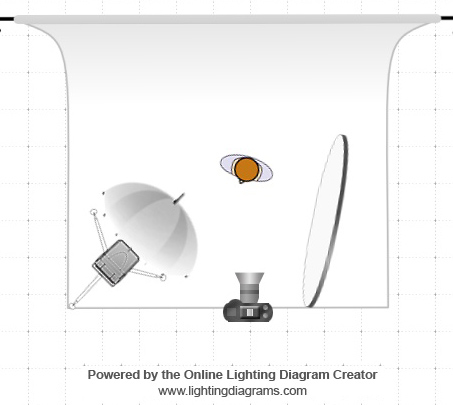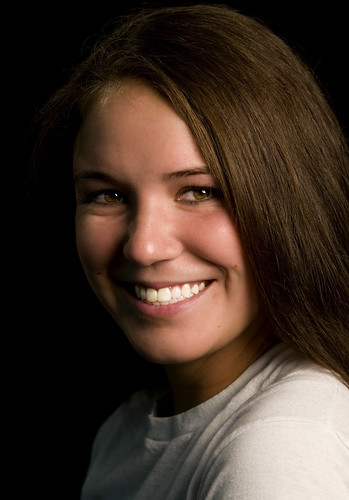
The basic portrait lighting set up
The umbrella represents the key light, the round reflector represents a fill light.
To do a basic light set up is easy.
Portraiture is a pursuit for photographers at all levels. Sometimes beginners shy away from anything but pop-up flash shots. They feel that they have an inadequate grasp of lighting techniques. Actually, the basic lighting for a portrait is very simple.
The essentials
In the diagram above there are four main components of the set-up plus the subject. There are…
- The backdrop, represented by the roll of paper mounted on the wall, down to the ground and under the subjects feet.
- The light, represented by the flash unit behind a photographic umbrella which diffuses the light.
- The reflector, the upright round object to the right of the camera.
- The camera itself, representing the position at which the photographer stands.
The light
In any photographic scene we refer to the main light as the “key light”. This is the main light source that brightens the scene and the subject. In most cases the basic set up will be using an off-camera flash. However, this type of flash is a very small light source. As such it tends to generate a very hard light. That is very unflattering light on the face. Hard, harsh shadows tend to create angular shadows. This is unflattering except in a dramatic mood or a shot emphasising maleness. To ensure that the light is more diffused the photographic umbrella is placed in front of the flash. This creates a soft light which is more flattering.
As you can see from the scene in the diagram the key light is angled on one side of the subject. Your portrait sitter will then be more strongly illuminated from one side. This leaves the other side of their face in shadow. You can fill out this shadow by using the reflector. It back-reflects the light from the flash. The reflected light will be more diffused and of a lower intensity than the flash-side of the face.

• Alex Broad Light 01 •
The light on the camera-side of the face is from a key light. The other side of the face is a lower intensity light.
• Alex Broad Light 01 • by Photo Geek, on Flickr![]()
The diffused flash on one side of the face and the slight shadow (filled by the reflector) on the other, creates a nice contrast. The difference in light across the face helps to create depth and structure. This is what photographers are looking for. We want to see nicely rounded features defined by the light-shadow relationship created by the gradient across the face.
In the diagram the angle of the key light and the reflector is a relatively shallow angle to the face. However, the angle can be varied. That variation will bring out the basic portrait lighting angles. You can read more about those in “Simple positions for classic portrait work”.
 Get Photokonnexion tips by email!
Get Photokonnexion tips by email!We send you tips daily – find out more…
Start email subscription now!
Lighting variations on a theme
This basic set up can be done even if you do not have off-camera flash or any kind of photographic light. The idea of a “key light” is that it is the main “light source”. In a studio that light could be a studio strobe light. In a house you might use the light coming in through the lounge window. An off-camera flash like above is another option or you could use some other form of lighting. In the outdoors the sun could be the key light.
In the case of the reflector you can use secondary sources of light instead. If you have a bright key light like flash or other light source you could use the lounge window as your secondary lower intensity light. I have seen fill done with a candle – lovely soft glow. Light from a reflector is only one way to create fill light.
The effect is all in the angles of the light relative to the face, and the gradient of light-to-shadow across the face. What you use to create the light is more about the way you take the photograph and the amount of light the camera needs to get a proper exposure. The motto is be creative with the way you create the light, and with the way you vary the angle of the key light and secondary light relative to the face.
Simplicity
The aim of this article has been to show how simple it is to set up a single light and a secondary source of light to create pleasing portraits. It is not difficult and it can be great fun if you have a good relationship with your portrait subject.
To get the most out of this tutorial you should also see: Simple portrait lighting for anyone to try (pt.2)
Photokonnexion Photographic Glossary – Definitions and articles.
Light and Lighting – Resource pages on Photokonnexion
Portraiture – Resource pages on Photokonnexion
Definition: Portraiture
Definition: Hard Light
Definition: Soft Light
Pop-up flash
Definition: Photographic Umbrella
“Simple positions for classic portrait work”
Definition: Off-camera flash; Flash, off-camera
Definition: Light source
Online Lighting Diagram Creator for photographers
We would love to have your articles or tips posted on our site.
Find out more…
Write for Photokonnexion.



